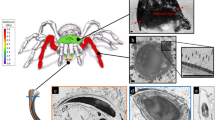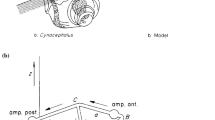Summary
-
1.
The stimulus conducting properties of the cuticular slit of slit sense organs (mechanoreceptors) in spiders were studied on the basis of models.
-
2.
Slits with different degrees of similarity to the actual shape of the sense organ were cut into plexiglass discs (Fig. 5). On these static pressure stresses were applied from varying directions (Fig. 2). The resulting deformations of the slit were measured in terms of compression, dilatation, and shear (Fig. 3).
-
3.
The deformation of the slits is greatest with the stress applied at right angle to their long axis. A copy of the troughlike shape found in the original sense organ considerably reduces the shear component on the outer side of the model slit. If furthermore the equivalent of the cuticular thickenings surrounding the original slit is added to the model, the deformation caused by stress appliedparallel to the slit's long axis is reduced. Thus the significance of deformations resulting from stress at right angle to the slit axis is enhanced (Figs. 6, 7).
-
4.
On the inner side of the slit the deformations are practically eliminated provided the trough-like shape and thickened frame of the original slit are copied in the model (Fig. 8).
-
5.
The deformation of single slits is greatest in their middle region and decreases towards their ends (Figs. 6, 7).
-
6.
The deformability of slits increases with their length (Fig. 9).
-
7.
Close to a slit sense organ the exocuticular lamellae run in a way very similar to the stress trajectories found around a notch in a bar, uniformly loaded in tension (Fig. 10).
Zusammenfassung
-
1.
In Modellversuchen werden die reizleitenden Eigenschaften des cuticularen Spaltes der Spaltsinnesorgane (Mechanoreceptoren) von Spinnen untersucht.
-
2.
Plexiglasmodelle zunehmend originalgetreuer Gestalt werden in Scheibenversuchen konstanter statischer Druckbelastung unterschiedlicher Richtung ausgesetzt (Abb. 5, 2). Die resultierende Verformung des äußeren und inneren Spaltrandes wird in Komponenten zerlegt und als Scherung, Kompression und Dilatation des Spaltrandes vermessen (Abb. 3).
-
3.
Die Verformung des Spaltes ist bei Belastung senkrecht zu seiner Längsachse am größten. Die Wannengestalt des Originals reduziert im Modell insbesondere die beim einfachen Durchgangsspalt großen Scherungswerte am Außenrand. Die zusätzliche originalgetreue Verstärkung der Spaltränder erhöht die relative Bedeutung der Verformung bei Belastung senkrecht zur Spaltlängsachse, indem sie die von achsenparalleler Belastung verursachte Verformung vermindert (Abb. 6, 7).
-
4.
Am Innenrand des Spaltes sind nach Einführung der Wannengestalt sowie der Randverstärkungen alle Verformungen praktisch eliminiert (Abb. 8).
-
5.
Alle Verformungskomponenten sind beim Einzelspalt im Mittelbereich der Außenseite am größten und nehmen zu den Spaltenden hin ab (Abb. 6, 7).
-
6.
Die Verformbarkeit der Spalten nimmt mit deren Länge zu (Abb. 9).
-
7.
Die exocuticularen Lamellen verlaufen in der Nähe eines Spaltsinnesorgans in Richtung der Linien der größten Hauptspannung an Kerben (Abb. 10).
Similar content being viewed by others
Literatur
Barth, F. G.: Ein einzelnes Spaltsinnesorgan auf dem Spinnentarsus: seine Erregung in Abhängigkeit von den Parametern des Luftschallreizes. Z. vergl. Physiol.55, 407–449 (1967).
Barth, F. G.: Die Feinstruktur des Spinneninteguments. I. Die Cuticula des Laufbeins adulter häutungsferner Tiere (Cupiennius salei Keys.). Z. Zellforsch.97, 137–159 (1969).
Barth, F. G.: Die Feinstruktur des Spinneninteguments. II. Die räumliche Anordnung der Mikrofasern in der lamellierten Cuticula und ihre Beziehung zur Gestalt der Porenkanäle (Cupiennius salei Keys., adult, häutungsfern, Tarsus). Z. Zellforsch.104, 87–106 (1970a).
Barth, F. G.: Der sensorische Apparat der Spaltsinnesorgane (Cupiennius salei Keys., Araneae). Z. Zellforsch.112, 212–246 (1971a).
Barth, F. G., Libera, W.: Ein Atlas der Spaltsinnesorgane vonCupiennius salei Keys. Chelicerata (Araneae). Z. Morph. Tiere68, 343–369 (1970b).
Flügge, W.: Festigkeitslehre. Berlin-Heidelberg-New York: Springer 1967.
Hackman, R. H.: Chemistry of insect cuticle. In: The physiology of insecta, (M. Rockstein, ed.), vol. 3, p. 471–502. New York: Academic Press Inc. 1964.
Jensen, M., Weis-Fogh, T.: Biology and physics of locust flight: V. Strength and elasticity of locust cuticle. Phil. Trans. B245, 137–169 (1962).
Liesenfeld, F. J.: Über Leistung und Sitz des Erschütterungssinnes von Netzspinnen. Biol. Zbl.80, 465–475 (1961).
Menges, G.: Werkstoffkunde der Kunststoffe. Sammlung Göschen Bd. 3002, Berlin: Walter de Gruyter & Co. 1970.
Mönch, E.: Technische Mechanik. München und Wien: R. Oldenbourg 1971.
Peterson, R. E.: Stress concentration design factors. New York-London-Sydney: John Wiley & Sons, Inc. 1966.
Pringle, J. W. S.: The function of the lyriform organs of arachnids. J. exp. Biol.32, 2, 270–278 (1955).
Walcott, Ch., Kloot, W. G. van der: The physiology of the spider vibration receptor. J. exp. Zool.141, 191–244 (1959).
Weber, E.: Grundriß der biologischen Statistik. VEB. Jena: G. Fischer Verlag 1964.
Author information
Authors and Affiliations
Additional information
Herrn Prof. Dr. Dr. h.c. H. Autrum, dem ich die Einführung in die Sinnesphysiologie verdanke, zum 65. Geburtstag.
Herrn Dipl. Ing. H. Marwitz vom Institut für Mechanik und Spannungsoptik der Technischen Universität München danke ich für zahlreiche Diskussionen, den Herren H.-P. Pickelmann und W. Vogl für wertvolle Mitarbeit und der Deutschen Forschungsgemeinschaft für finanzielle Unterstützung.
Rights and permissions
About this article
Cite this article
Barth, F.G. Die Physiologie der Spaltsinnesorgane. J. Comp. Physiol. 78, 315–336 (1972). https://doi.org/10.1007/BF00697661
Received:
Issue Date:
DOI: https://doi.org/10.1007/BF00697661




